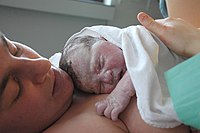
Photo from wikipedia
Background: Skin-to-skin contact (SSC) has been demonstrated to allow adequate thermal stability in high-technology settings with extremely preterm infants, while other aspects on how SSC influences basic physiological parameters have… Click to show full abstract
Background: Skin-to-skin contact (SSC) has been demonstrated to allow adequate thermal stability in high-technology settings with extremely preterm infants, while other aspects on how SSC influences basic physiological parameters have been less extensively investigated. Purpose: To evaluate physiological stability during SSC and incubator care in a group of preterm infants born at a gestational age (GA) of 32 weeks or less and receiving respiratory support. Methods: Descriptive, observational study including 10 preterm infants (GA 22-32 weeks, postnatal age 2-48 days) were evaluated during SSC compared with flanking time periods in the incubator. Cerebral and systemic regional oxygen saturation (rSao2), pulse oximetry (Spo2), heart rate (HR), and body temperature were recorded, and the fractional tissue oxygen extraction (fTOE) was calculated. Results: A total of 16 periods of SSC (mean duration 3 hours 30 minutes) were evaluated, 9 during nasal continuous positive airway pressure and 7 during mechanical ventilation. Cerebral rSao2 was 68% ± 4% (SE) and 69% ± 4% during incubator care and SSC, respectively (P = .56). Somatic rSao2 was 64% ± 4% during incubator care and 66% ± 4% during SSC (P = .54). Also, fTOE, HR, and Spo2 was similar during the 2 modes of care. Body temperature increased during SSC (P < .01). Implications for Practice: The present study reveals no differences in cerebral and somatic tissue oxygenation between periods of SSC and care in the incubator. The findings indicate that SSC supports physiological stability also during management of very preterm infants receiving respiratory support. Implications for Research: Further studies directed to further optimize SSC performance should enable its safe implementation at gradually lower gestational and postnatal ages.
Journal Title: Advances in Neonatal Care
Year Published: 2020
Link to full text (if available)
Share on Social Media: Sign Up to like & get
recommendations!